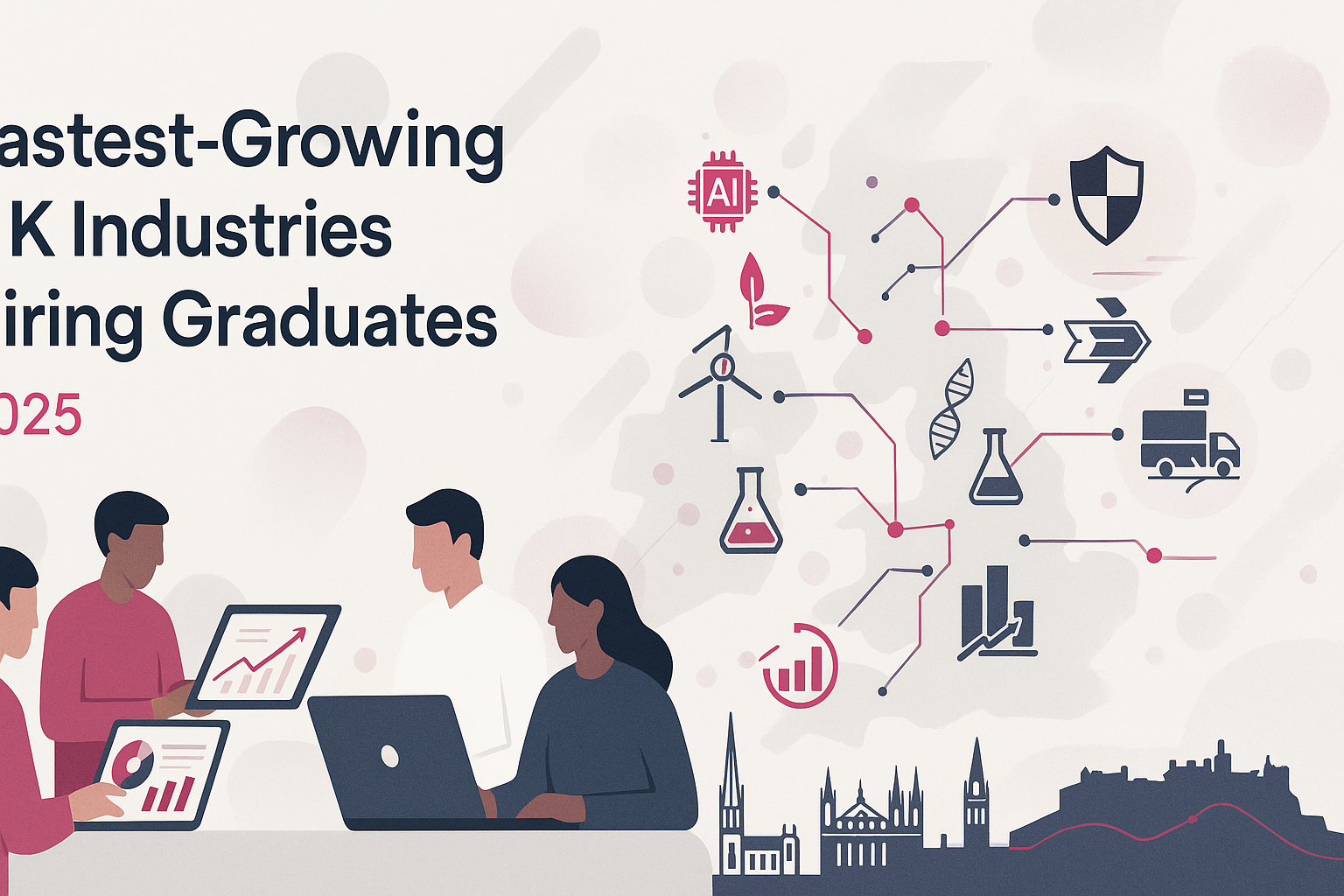
Fastest-Growing UK Industries Hiring Graduates in 2025
Introduction
You do not need luck to start strong in 2025. You need focus. The UK economy is reshaping fast, and several sectors are scaling headcount despite noise elsewhere. If you aim at the right industries, build relevant proof-of-work, and execute a tight job search, you will cut your time-to-offer dramatically. This guide shows you exactly where to aim and what to do next.
Why these sectors are scaling now
Demand is not evenly spread. Structural drivers are concentrating growth in specific areas: digital transformation, energy transition, geopolitics, ageing demographics, infrastructure renewal, and the explosion of data. Employers in these sectors are hiring graduates for one simple reason: they need fresh capacity, fast. The work is priority, the budgets are approved, and capability gaps are obvious. That is where you should compete.
How to read growth signals (so you do not chase hype)
Follow funding and regulation: when policy aligns with capital, hiring follows. Think energy, defence, life sciences, and digital public services.
Watch infrastructure projects and corporate roadmaps: grid upgrades, 5G rollouts, hospital digitisation, and cyber resilience roadmaps create multi‑year demand.
Track skills shortages, not headlines: if job descriptions repeat the same skill clusters across employers, that is a hiring signal.
Prioritise teams closest to revenue, risk, or compliance: those lines get budget protection in any market.
12 fastest‑growing UK industries hiring graduates in 2025
Technology: AI, Data, Cybersecurity, Cloud, and DevOps
Growth drivers
AI adoption, relentless cloud migration, security threats, and the need to monetise data. Every sector is now a software‑enabled business.
Typical graduate roles
Data analyst, BI developer, junior data engineer
Security analyst, SOC analyst, GRC associate
Cloud support engineer, SRE associate, DevOps assistant
Software developer, QA engineer, product analyst
Core skills to build
SQL, Python, data modelling basics, version control
Linux fundamentals, networking, identity and access management
Cloud foundations (AWS, Azure, or GCP) and CI/CD basics
Secure coding, OWASP awareness, threat modelling fundamentals
Proof‑of‑work that gets interviews
A reproducible analytics project with a cleaned dataset, clear README, and insights that drive action
A small cloud deployment with IaC, automated tests, and monitoring
Participation in a Capture‑the‑Flag or a security lab with documented learnings
Rapid route‑to‑entry
Pick a product problem.
Ship a small solution.
Document it like a pro.
Get feedback from practitioners.
Iterate and apply with tailored CVs.
FinTech and Digital Payments
Growth drivers
Open banking, embedded finance, fraud prevention, and the digitisation of credit and KYC. London remains a global fintech hub with scale‑ups hiring graduates.
Typical graduate roles
Risk analyst, fraud analyst, AML/KYC analyst
Product analyst, operations associate, customer success engineer
Data analyst focused on payments flows and unit economics
Core skills to build
SQL for transaction data, cohort analysis, funnel metrics
Payments flows, chargebacks, PSD2, AML/KYC basics, FCA context
Experimentation literacy and product analytics
Proof‑of‑work
Mock a payments funnel, calculate approval rates, fraud rates, and LTV/CAC from sample data
Write a one‑pager redesign of an onboarding flow with risk controls
Rapid route‑to‑entry
Target companies with live graduate intakes and operational scale. Show you understand risk, regulators, and unit economics.
Green Energy and Climate Tech (Renewables, Grid, Heat, EV, Carbon)
Growth drivers
Net‑zero commitments, electrification of heat and transport, grid modernisation, and the growth of onshore/offshore wind and solar.
Typical graduate roles
Renewable energy analyst, energy markets analyst
Junior project engineer, commissioning assistant, asset management analyst
Carbon accounting associate, sustainability analyst
Core skills to build
Energy systems basics, capacity factors, grid constraints
Power purchase agreements, CfD awareness, carbon reporting frameworks
Excel modelling, Python for analysis, GIS basics
Proof‑of‑work
A mini energy model showing generation profiles and demand curves with a short memo on grid implications
A concise carbon footprint assessment for a small business, referencing recognised frameworks
Rapid route‑to‑entry
Apply to developers, asset owners, grid consultancies, and climate tech start‑ups. Show quantitative rigour and policy literacy.
Life Sciences, Pharma, and MedTech
Growth drivers
Bio‑innovation, AI‑enabled drug discovery, manufacturing resilience, and medtech adoption in clinical settings.
Typical graduate roles
Research associate, lab technician, bioinformatics assistant
QA/RA associate, clinical trials coordinator
Health economics and outcomes research (HEOR) analyst
Core skills to build
Good Laboratory Practice, data integrity, statistics
Regulatory pathways basics, documentation discipline
Python/R for analysis, FAIR data principles
Proof‑of‑work
A clean, replicable analysis of a public biomedical dataset with clear methodology
A short mock clinical trial protocol summary and risk register
Rapid route‑to‑entry
Target clusters in the Golden Triangle and key regions. Emphasise documentation, safety, and statistical competence.
Defence, Aerospace, and Space
Growth drivers
Geopolitics, increased defence budgets, and commercial space growth. Cyber, sensing, autonomy, and secure communications are hot.
Typical graduate roles
Systems engineer, test engineer, quality engineer
Intelligence analyst, electronic warfare analyst
Space operations analyst, mission design assistant
Core skills to build
Systems engineering mindset, requirements traceability, testing
Basic RF, sensor fusion basics, MATLAB/Python
Security clearance awareness, export control basics
Proof‑of‑work
A systems V‑model for a hypothetical UAV subsystem with a test plan
A satellite mission concept note with constraints and trades
Rapid route‑to‑entry
Apply early due to clearances. Emphasise rigour, documentation, and ethics of safety‑critical work.
Advanced Manufacturing, Semiconductors, and Robotics
Growth drivers
Reshoring critical supply chains, automation to offset labour constraints, and demand for precision engineering.
Typical graduate roles
Manufacturing engineer, process engineer, yield analyst
Robotics technician, automation engineer, controls engineer
Quality engineer, reliability analyst
Core skills to build
Lean fundamentals, SPC, FMEA, root cause analysis
PLCs, ROS basics, sensors and actuators
CAD, GD&T, Python for data capture and analysis
Proof‑of‑work
A mini continuous improvement project with before‑and‑after metrics
A simple robot simulation showing path planning with a write‑up
Rapid route‑to‑entry
Target plants ramping production and vendors building automation. Show actual problem‑solving on hardware or simulated systems.
Built Environment and Infrastructure (Energy, Rail, Water, Housing)
Growth drivers
Decarbonisation, grid upgrades, resilience, and housing needs. Capital projects require multi‑year graduate pipelines.
Typical graduate roles
Graduate civil engineer, project coordinator, BIM technician
Environmental consultant, utilities planner, asset analyst
Quantity surveyor, planning assistant
Core skills to build
Project controls, Primavera/MS Project basics, risk registers
BIM fundamentals, GIS, environmental assessment literacy
CDM Regulations, HSE awareness, method statements
Proof‑of‑work
A phase‑by‑phase Gantt and risk log for a small works project with mitigation actions
A BIM or GIS mini‑project with clear layers and assumptions
Rapid route‑to‑entry
Apply to contractors, consultancies, and asset owners. Show you understand cost, schedule, risk, and safety.
E‑commerce, Digital Retail, and Supply Chain Logistics
Growth drivers
Omnichannel retail, last‑mile innovation, warehouse automation, and relentless focus on unit economics.
Typical graduate roles
Supply chain analyst, demand planner, inventory analyst
Ecommerce trading executive, CRO analyst, performance marketing analyst
Operations graduate, fulfilment optimisation analyst
Core skills to build
Excel and SQL for forecasting and stock optimisation
Funnel analytics, A/B testing, attribution concepts
Process mapping, continuous improvement, warehouse KPIs
Proof‑of‑work
A forecasting notebook comparing methods on historical sales data
A conversion‑rate audit with prioritised test ideas and expected impact
Rapid route‑to‑entry
Target retailers with strong digital operations and 3PL providers. Show you can move metrics fast.
Professional and Business Services (Consulting, Audit, Tax, Legal Ops)
Growth drivers
Regulatory change, digital transformation, and demand for cost‑efficient expertise. Firms are scaling graduate intakes to meet client demand.
Typical graduate roles
Consulting analyst, transformation analyst, PMO analyst
Audit associate, tax associate, risk and compliance analyst
Legal operations associate, eDiscovery analyst
Core skills to build
Structured problem‑solving, stakeholder mapping, requirements gathering
Data literacy, visualisation, and presentation clarity
Familiarity with controls, risk frameworks, and process design
Proof‑of‑work
A crisp case study showing problem, analysis, options, decision, and quantified impact
A process map with controls and measurement points
Rapid route‑to‑entry
Train for case interviews and aptitude tests. Demonstrate disciplined thinking and client‑ready communication.
Public Sector Digital and NHS Data
Growth drivers
Service digitisation, cyber resilience, interoperability, and data‑driven decision‑making in health and government.
Typical graduate roles
Data analyst, information governance assistant, digital services associate
Business analyst, product analyst, user researcher
Cyber analyst in SOC or assurance roles
Core skills to build
Data privacy, IG, and health data standards awareness
Service design basics and user‑centred research methods
Security fundamentals and risk management
Proof‑of‑work
A service blueprint for a common public service pain point with measurable outcomes
A de‑identified dataset analysis that improves a patient‑relevant KPI
Rapid route‑to‑entry
Apply early to government fast streams and NHS trusts. Emphasise public value and accountability.
Creative Digital, Gaming, and Media Tech
Growth drivers
UK creative IP, gaming exports, streaming, and rapid toolchain advances in content creation.
Typical graduate roles
Junior game developer, technical artist, QA tester
Content strategist, video editor, social performance analyst
Adtech analyst, martech specialist, product analyst
Core skills to build
Engine basics (Unity/Unreal), scripting, build pipelines
SEO, CRO, analytics tools, short‑form video production
Experimentation literacy and user metrics
Proof‑of‑work
A small playable demo with a bug list and iteration history
A content calendar plus performance dashboard with insights and next actions
Rapid route‑to‑entry
Show shipped work, not talk. Build a lean portfolio and contribute to game jams or creator projects.
AgriTech and FoodTech
Growth drivers
Food security, controlled‑environment agriculture, supply chain transparency, and sustainability pressures.
Typical graduate roles
Operations analyst, precision agriculture technician
Product analyst, sensor data analyst, quality associate
Sustainability analyst, traceability analyst
Core skills to build
IoT basics, sensor data handling, dashboarding
HACCP, quality systems, sustainability reporting
SQL, Python, GIS mapping for farms and logistics
Proof‑of‑work
A small sensor data analysis with anomaly detection and actionable recommendations
A traceability flow diagram with controls and data capture points
Rapid route‑to‑entry
Target fast‑growing scale‑ups and retailers’ innovation arms. Show practical impact on yield, waste, or quality.
Skills that compound across all growth sectors
Analytical fluency: SQL, Excel, and at least one scripting language to interrogate data and automate tasks
Systems thinking: the ability to map inputs, constraints, and feedback loops before proposing fixes
Secure‑by‑design mindset: privacy, access control, and risk thinking baked into everyday decisions
Product literacy: understanding of users, value, and experimentation to drive outcomes
Documentation quality: clear requirements, acceptance criteria, and reproducible steps
Communication discipline: short memos, crisp metrics, and confident stakeholder updates
Commercial awareness: how your work moves revenue, margin, cost, risk, or compliance
Target employers and regional hotspots
London: fintech, consulting, cyber, media tech, ecommerce, and scale‑ups across functions
Cambridge and Oxford: life sciences, deep tech, AI, and advanced manufacturing
Manchester and Leeds: digital, ecommerce, health data, media, and professional services
Bristol and Bath: aerospace, robotics, semiconductor design, and creative tech
Edinburgh and Glasgow: fintech, data science, gaming, and public sector digital
Birmingham and the Midlands: automotive, manufacturing, logistics tech, professional services
Newcastle, Sheffield, and Liverpool: energy systems, health tech, and advanced materials
Cardiff and Belfast: cyber, fintech, and public sector digital programmes
Action: shortlist three hubs aligned to your target sector and apply in clusters, not one‑offs.
Tactics that actually land interviews in growth sectors
Reverse‑engineer five job descriptions: extract recurring skills, tools, and outcomes. Build a micro‑portfolio proving each.
Ship one weekend project per week for four weeks: small, focused, and measurable. Public repo, clear README, and a short Loom walkthrough.
Use problem‑first outreach: message hiring managers with a 150‑word note summarising a relevant problem and your tested solution.
Exploit graduate schemes and direct entry in parallel: schemes for structure, direct hires for speed.
Pass the filters: tailor your CV to the job’s language, mirror keywords naturally, and prove impact with numbers.
Validate with practitioners: ask for 15‑minute feedback on your artefacts. Iterate. Mention improvements in interviews.
Present like a professional: three slides only — problem, approach, result — with numbers and next steps.
Close with momentum: after interviews, send a concise follow‑up memo with clarifications and a small extra insight.
CV and LinkedIn positioning for high‑growth industries
Headline with target function and sector: “Graduate Data Analyst | Energy Systems and Markets” beats vague statements
Pin three portfolio items that map to job outcomes, not academic modules
Quantify everything: “reduced analysis time by 40% with an automated pipeline”
Earn a relevant micro‑credential if it removes doubt: cloud fundamentals, security basics, or sector‑specific compliance
Add a clean, structured skills section: tools, languages, frameworks, and domain knowledge
Use recommendations wisely: one from a practitioner who reviewed your work is worth more than three generic quotes
Interview preparation that matches how teams actually work
Technical: rehearse fundamentals, not trivia. Data types, joins, indexes, complexity, HTTP, IAM, and version control etiquette
Case and product: define the problem, list constraints, propose options, choose, and quantify expected impact
Practical task: timebox, state assumptions, leave logs, and write a handover note that a teammate can use tomorrow
Behavioural: use precise episodes with context, conflict, actions, and outcomes; show resilience and learning velocity
30‑60‑90 day plan once you land the role
Days 1–30
Map the system: people, processes, data, and risks
Ship a quick win: a small fix that saves time or reduces errors
Learn the rituals: stand‑ups, reviews, and decision forums
Days 31–60
Own a measurable outcome: a dashboard, a test suite, a process improvement, or an automation
Improve documentation: clarify runbooks, checklists, and definitions of done
Build relationships: shadow adjacent teams and understand their metrics
Days 61–90
Propose a roadmap for the next quarter with two to three high‑impact items
Share results and lessons in a short internal write‑up
Ask for feedback, set new targets, and lock in stakeholder support
Common mistakes that cost offers
Applying without proof: a degree alone is not a differentiator in 2025
Building projects no employer cares about: align artefacts to job outcomes
Ignoring compliance and security: every growth sector is governed; show awareness
Over‑indexing on tools: fundamentals outlast tools; learn principles first
Weak follow‑up: send concise, useful updates after every interview stage
Your next steps
Pick one sector from this list. In the next seven days, build a small, relevant artefact that proves you can contribute. In two weeks, secure two practitioner reviews and iterate. In three weeks, apply to ten roles with tailored CVs and problem‑first outreach. That is how you convert intent into an offer in a growth market.
Final word
You are not competing with “everyone”. You are competing with those who can prove value fast. Target the sectors where demand is scaling, speak the language of outcomes, and show your work. Do this with discipline and you will not be waiting long for your first offer.
Next Steps
Want to learn more? Check out these articles:
How to Hit the Ground Running in a New Job: A Tactical Guide
10 Critical Things Employers Look for in a CV [Expert Insights]
Know Your Customer: The Secret to Creating Unique and Personalised Customer Experiences
Check out our Advanced Employability Course for all the help you need to get your dream job, fast.


